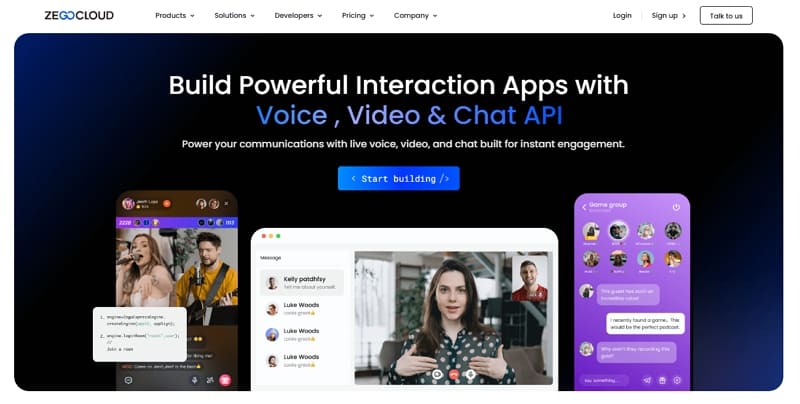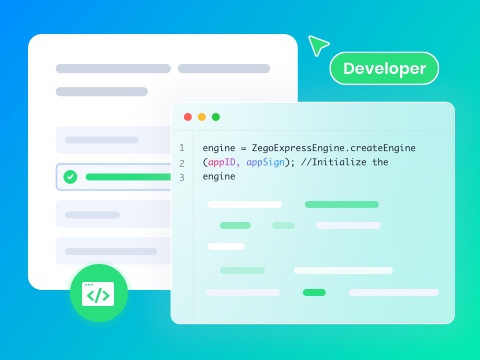These days, technological advancements have brought new opportunities and challenges for users worldwide. Notably, it is more evident in the world of web technology, which continues to evolve with new innovations almost every day. Along with its growth, the demands for dynamic and responsive websites also keep rising. Also, as developers strive to create effortless user experiences, staying updated with the latest tools and frameworks becomes essential. Thus, this deep dive will explore the top 10 web technologies that every developer should keep an eye on.
What is Web Technology?
Before going any further, let’s go through the basics to explain what is meant by “Web Technology.” In short, it is a general term for the various tools and technologies needed to create and manage websites. To simplify it further, this concept includes everything that powers the internet for users. From the creation of websites to the way they interact with users, each aspect is a web technology.
Programming languages like CSS and JavaScript are important parts of this tech, as it becomes hard to structure and add interactivity to web pages without them. Additionally, web technologies cover various frameworks, libraries, and content management systems that help create your desired platforms. Moreover, technologies on the server’s end and databases helping the functionality and performance of websites are also a part of it.
Classification of Web Technologies
As the components considered to be part of this category are too broad, understanding them without a structure will be near impossible. Therefore, web development technologies have been classified into different major and minor categories on the basis of their functionality and purpose. Summarized below is an overview of the primary classification system used for them:
1. Frontend Technologies
The part of a website where the user interacts directly or the client side is what we call the “Frontend.” Besides, tools and services that focus on the part of web development are the ones called “Frontend Technologies.” From layout to design and user experience, they handle everything a user interacts with on a site. Additionally, some key ones include:
- HTML: Structures web pages.
- CSS: Styles and formats web content.
- JavaScript: Adds interactivity and dynamic elements.
- Frontend Frameworks and Libraries: React, Angular, and Vue.js
2. Backend Technologies
Secondly, these are responsible for operations on the server side, like processing requests and managing databases to ensure the web apps work fine. As for their main role, they are the important hidden soldiers that keep everything important for a website to work and function. Thus, key backend technologies include:
- Server-Side Languages: Node.js, Python, PHP, Ruby on Rails.
- Databases: MySQL, PostgreSQL, MongoDB, Firebase.
- Web Servers: Apache, Nginx, Microsoft IIS.
3. Full-Stack Technologies
These are the results when you combine both frontend and backend technologies to create a comprehensive web application. Also, full-stack developers work programming for the clients’ side on the server’s end. Anyhow, some popular ones include:
- MEAN Stack: MongoDB, Express, Angular, and Node.js.
- MERN Stack: MongoDB, Express, React, and Node.js.
- LAMP Stack: Linux, Apache, MySQL, and PHP.
4. Web Development Tools
From building to testing its functionality, many programs and services help developers in all tasks of creating a web app. Therefore, you will need them to optimize the workflow and ensure the quality of the final product matches the standards in the industry. Hence, examples include:
- Version Control: Git and GitHub for code management.
- Package Managers: npm, Yarn, and Composer for dependency management.
- Build Tools: Webpack, Gulp, and Grunt for task automation.
5. Web Security Technologies
A grave threat faced by sites on a constant basis is cyber-attacks. Moreover, these security technologies ensure your website does not become a victim of successful hacking. For now, key practices and technologies in this regard include:
- HTTPS: Encrypts data between the server and the browser.
- Authentication and Authorization: OAuth, JWT (JSON Web Tokens), and session management.
- Web Application Firewalls (WAF): Protection against threats like SQL injection and cross-site scripting (XSS).
10 Frontend and Backend Web Technologies You Must Know
With the growth in the digital world, web development remains an important part of it. Thus, from building dynamic designs to creating powerful, server-side apps, mastering the right tools is essential. Therefore, we have explained the top 10 newest web development technologies that you must know:
1. HTML
It is the basic building block of the web, which defines the meaning and structure of web content. Regarding its purposes, it also uses a series of tags to define elements like headings, images, and more. With HTML5, developers gained new features such as enhanced multimedia support and better integration with modern web applications. Ultimately, this web technology example remains a foundational block every web developer must master.
2. CSS
This is primarily a styling language used to control the appearance and layout of web pages. As for its functionality, it works alongside HTML to apply styles to elements such as colors and fonts. Despite that, it lets developers create websites that cater to different screen sizes and system. With features like Flexbox and Grid, this language from the web technologies list helps design complex layouts.
3. JavaScript
A powerful and dynamic programming language, it brings interactivity and functionality to websites. Commonly. Moreover, JavaScript runs in the browser to let developers create interactive elements. Animations and real-time updates without refreshing the page are its specialties.
This web development trend helps with important tasks like checking data, responding to user actions, and handling requests without delays. That’s because it is so flexible and widely used; it is a key part of front-end development.
4. Vue.js
Among the latest JS frameworks, this one is for building interactive user interfaces and single-page applications. Vue.js is a user favorite for its simplicity and flexibility in letting developers build scalable web apps with ease. In addition to that, it provides features such as a two-way data binding architecture and a reactive data model. Furthermore, Vue.js is part of the latest web technologies and is lightweight.
5. Node.js
It is a tool that lets developers use JS on servers, not just in web browsers. Node.js helps create fast and powerful apps, and developers use it for tasks like handling data and building APIs. As one of the latest web development technologies, it can manage many connections at the same time without slowing down, making it great for modern web applications.
6. Python
Other than being a powerful programming language, it is also one of the newest web development technologies. It has become especially useful for tasks like data analysis and automation purposes in recent times. Since it is relatively easier and simpler to learn, Python is more popular for coding purposes. Additionally, developers can read and translate its code much easier since it requires a unique syntax focusing on readability.
7. Java
Based on Object-Oriented Programming principles, this language organizes software design around objects. With that powerful ability, Java makes it easier to manage large programs and code reuse. Additionally, it follows the principle of “write once, run anywhere” with all its heart.
As a matter of fact, Java can run on any device that supports the JVM. In web development trends, you will find it on the server-side applications that power websites.
8. SQL
Structured Query Language is a web technology famous for managing and interacting with databases. As for its functions, it lets developers code query, insert, update, and delete data stored in tables. Not to mention that SQL is essential for retrieving specific content from large datasets while performing complex queries and ensuring data integrity. Among its common operations, queries like SELECT, INSERT, UPDATE, and DELETE are some that almost everybody knows.
9. TypeScript
Users looking for some extra features in JavaScript can opt for this programming language. Among developers, it’s mainly a favored choice to make complex JavaScript programs easier to work with and more reliable. Additionally, it enhances JavaScript by providing features like type annotations, interfaces, and advanced object-oriented programming capabilities. In web development technologies, TypeScript lets you specify what kind of data a variable should hold.
10. Laravel
Widely used by developers to build websites and web apps, it is a programming language that makes things easier and faster. Notably, Laravel is like a set of pre-made tools and rules that help you organize and manage your code better.
Furthermore, it simplifies common tasks such as routing, authentication, and database management. Among the web technologies listed, Laravel follows the MVC pattern to separate logic, data, and presentation layers.
How ZEGOCLOUD Empowers Web Developers in Web Technology Application
ZEGOCLOUD helps developers by providing tools and services that simplify the creation of communication applications. It lets them easily add calling and messaging features to their websites and applications by providing reliable APIs and Software Development Kits. Hence, you don’t have to build things from scratch, simplifying the process of adding communication capabilities to your tools.

Key Features of ZEGOCLOUD that are benefiting web developers:
1. WebRTC Integration for Seamless Real-Time Communication
Web developers can leverage ZEGOCLOUD’s WebRTC-based SDKs to implement high-quality audio and video calls in their applications. The WebRTC support ensures low latency, high-definition streaming, and enhanced user engagement across browsers without requiring additional plugins.
2. Cross-Browser and Cross-Platform Compatibility
ZEGOCLOUD’s solutions work seamlessly across various browsers and devices, ensuring a smooth user experience regardless of the operating system. This is crucial for web developers aiming to reach a broad audience with minimal compatibility issues.
3. Scalable and Customizable UIKits
Developers can take advantage of ZEGOCLOUD’s pre-built UIKits, which are fully customizable. These kits allow for rapid deployment of chat and video conferencing features while maintaining brand consistency and user interface fluidity.
4. High Performance with Low Latency
ZEGOCLOUD optimizes data transmission using advanced network protocols, ensuring minimal latency and a lag-free experience. This is especially beneficial for applications requiring real-time interaction, such as online gaming, virtual classrooms, and telehealth solutions.
Conclusion
To conclude, developers can take benefit of the improved technology to create responsive applications and platforms. They can combine basic frontend languages with technologies such as Python and SQL to create powerful websites.
Additionally, creating new platforms becomes even easier by using APIs and SDKs from platforms like ZEGOCLOUD. Hence, developers can use these web technologies together to create modern communication tools effortlessly.
Read more:
FAQ
Q1: What is web technology?
Web technology is a collection of tools, languages, and frameworks for creating, managing, and interacting with websites and web apps. It includes front – end (e.g., HTML, CSS, JavaScript) and back – end (e.g., server – side languages, databases) components.
Q2: How many types of web technology are there?
Broadly, there are three main types: front – end, back – end, and full – stack. Each has various sub – types like programming languages and frameworks.
Q3: Is web technology a good career?
Yes. High demand for web tech skills exists due to internet growth. It offers diverse jobs, creativity, remote work options, and good pay as you gain experience.
Q4: Is HTML a web technology?
Yes. HTML is a key web technology. It structures web page content, allowing browsers to display information.
Let’s Build APP Together
Start building with real-time video, voice & chat SDK for apps today!










